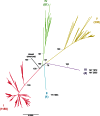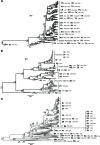Worldwide spread of Dengue virus type 1
- PMID: 23675416
- PMCID: PMC3652851
- DOI: 10.1371/journal.pone.0062649
Worldwide spread of Dengue virus type 1
Abstract
Background: DENV-1 is one of the four viral serotypes that causes Dengue, the most common mosquito-borne viral disease of humans. The prevalence of these viruses has grown in recent decades and is now present in more than 100 countries. Limited studies document the spread of DENV-1 over the world despite its importance for human health.
Methodology/principal findings: We used representative DENV-1 envelope gene sequences to unravel the dynamics of viral diffusion under a Bayesian phylogeographic approach. Data included strains from 45 distinct geographic locations isolated from 1944 to 2009. The estimated mean rate of nucleotide substitution was 6.56 × 10⁻⁴ substitutions/site/year. The larger genotypes (I, IV and V) had a distinctive phylogenetic structure and since 1990 they experienced effective population size oscillations. Thailand and Indonesia represented the main sources of strains for neighboring countries. Besides, Asia broadcast lineages into the Americas and the Pacific region that diverged in isolation. Also, a transmission network analysis revealed the pivotal role of Indochina in the global diffusion of DENV-1 and of the Caribbean in the diffusion over the Americas.
Conclusions/significance: The study summarizes the spatiotemporal DENV-1 worldwide spread that may help disease control.
Conflict of interest statement
Figures





Similar articles
-
Phylogeography and evolutionary history of dengue virus type 3.Infect Genet Evol. 2009 Jul;9(4):716-25. doi: 10.1016/j.meegid.2008.10.005. Epub 2008 Oct 25. Infect Genet Evol. 2009. PMID: 19010450
-
Evolutionary history and spatiotemporal dynamics of DENV-1 genotype V in the Americas.Infect Genet Evol. 2016 Nov;45:454-460. doi: 10.1016/j.meegid.2016.09.025. Epub 2016 Oct 3. Infect Genet Evol. 2016. PMID: 27713055
-
Phylogeography and population dynamics of dengue viruses in the Americas.Mol Biol Evol. 2012 Jun;29(6):1533-43. doi: 10.1093/molbev/msr320. Epub 2012 Jan 6. Mol Biol Evol. 2012. PMID: 22319149 Free PMC article.
-
Unraveling Dengue Virus Diversity in Asia: An Epidemiological Study through Genetic Sequences and Phylogenetic Analysis.Viruses. 2024 Jun 28;16(7):1046. doi: 10.3390/v16071046. Viruses. 2024. PMID: 39066210 Free PMC article. Review.
-
Origin, tempo, and mode of the spread of DENV-4 Genotype IIB across the state of São Paulo, Brazil during the 2012-2013 outbreak.Mem Inst Oswaldo Cruz. 2019 Jan 7;114:e180251. doi: 10.1590/0074-02760180251. Mem Inst Oswaldo Cruz. 2019. PMID: 30624458 Free PMC article. Review.
Cited by
-
The great potential of entomopathogenic bacteria Xenorhabdus and Photorhabdus for mosquito control: a review.Parasit Vectors. 2020 Jul 29;13(1):376. doi: 10.1186/s13071-020-04236-6. Parasit Vectors. 2020. PMID: 32727530 Free PMC article. Review.
-
Phylogenetics, Epidemiology and Temporal Patterns of Dengue Virus in Araraquara, São Paulo State.Viruses. 2024 Feb 9;16(2):274. doi: 10.3390/v16020274. Viruses. 2024. PMID: 38400049 Free PMC article.
-
Origin and Spread of the Dengue Virus Type 1, Genotype V in Senegal, 2015-2019.Viruses. 2021 Jan 4;13(1):57. doi: 10.3390/v13010057. Viruses. 2021. PMID: 33406660 Free PMC article.
-
Retrospective epidemiologic and genomic surveillance of arboviruses in 2023 in Brazil reveals high co-circulation of chikungunya and dengue viruses.BMC Med. 2024 Nov 20;22(1):546. doi: 10.1186/s12916-024-03737-w. BMC Med. 2024. PMID: 39567979 Free PMC article.
-
In Silico Comparative Analysis of Predicted B Cell Epitopes against Dengue Virus (Serotypes 1-4) Isolated from the Philippines.Vaccines (Basel). 2022 Aug 5;10(8):1259. doi: 10.3390/vaccines10081259. Vaccines (Basel). 2022. PMID: 36016147 Free PMC article.
References
-
- Theiler M, Downs WG (1973) The arthropod-borne viruses of vertebrates. An account of The Rockefeller Foundation Virus Program, 1951–1970. London: Yale University Press. 606 p.
-
- Karabatsos N (1985) Supplement to International Catalogue of Arboviruses Including Certain Other Viruses of Vertebrates. San Antonio, Texas : American Society of Tropical Medicine and Hygiene. - PubMed
-
- Fagbami AH, Monath TP, Fabiyi A (1977) Dengue virus infections in Nigeria: a survey for antibodies in monkeys and humans. Trans R Soc Trop Med Hyg 71: 60–65. - PubMed
-
- Simmons CP, Farrar JJ, Nguyen VV, Wills B (2012) Dengue. N Engl J Med 366: 1423–1432. - PubMed
Publication types
MeSH terms
Substances
LinkOut - more resources
Full Text Sources
Other Literature Sources
Medical

